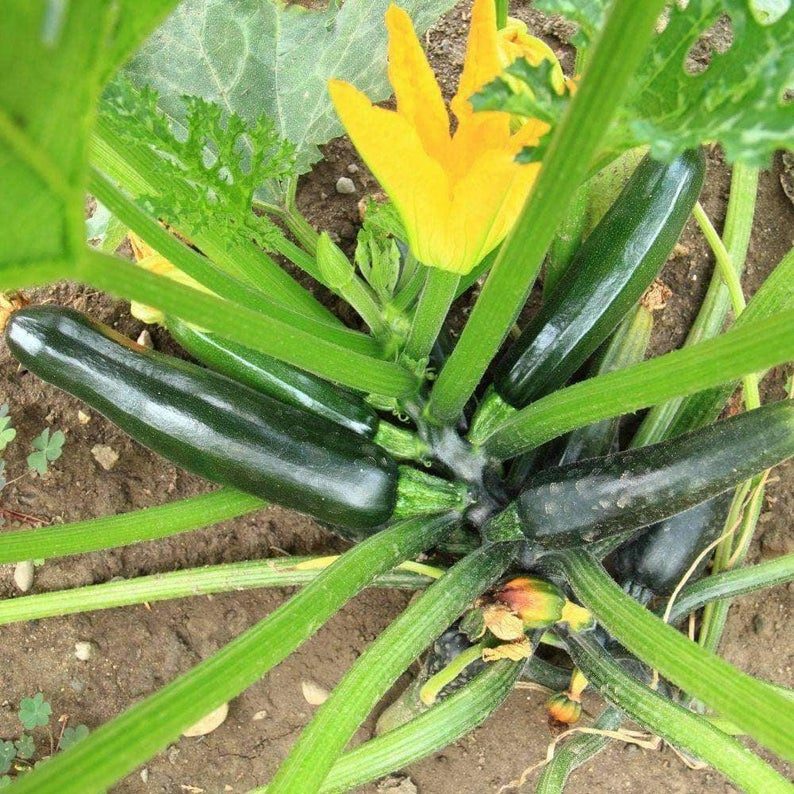Learn about growing zucchini successfully. Gardening can be expensive and takes time. Do it right the first time. Whether you are a beginner gardener or experienced, growing a zucchini plant is easy when you give it enough room, use good soil, care for it, and possibly, help it pollinate.
This summer squash is simple to cultivate. You just need a few plants to grow up to 10 pounds of zucchini. There are two ways to do it: from starts (plants you buy from the store which are already growing) or seeds. You may want to plant seeds early in the season and as it gets warmer, also plant starts.
Where to Buy Zucchini Plants and Seeds
You can buy zucchini starts at your local nursery or stores such as Menards, Home Depot, Lowe’s, Ace Hardware, etc. Zucchini seeds will also likely be available in these stores, or you can order them online.
Choose organic seeds or heirloom varieties if possible as the price difference is negligible. When you are more experienced, you can learn how to save zucchini seeds and plant them again if you choose.
Availability, costs (it’s more expensive to buy small established plants than to buy seeds), time commitment, and how early or late in the season it is can be deciding factors if you plant from seed or starts.
Pollinating Zucchini So the Flowers Fruit
While zucchini plants will grow prolifically alone, you want to be sure the flowers grow into fruits. The female flowers will only fruit (turn into zucchinis) with pollination. If you find some female flowers are dying off and not fruiting, you will need to pollinate by hand. (More on this below).
Plant to grow several plants so you can have male and female flowers open at the same time.
When to Plant Zucchini
Zucchini grows well in most climate zones as long as you plant it after the last frost. It’s a warm season crop. In warmer areas that may be February while in others that can be mid-to-late March, April, and into May. Plant two weeks after the last frost date for your area. (More on your area below.)
Keep reading for tips for planting zucchini and how to grow zucchini. Growing this summer squash is one way to be sure you have success with a vegetable garden. The scientific name for a zucchini plant is Cucurbita pepo subsp. pepo var. melopepo.
Growing Zucchini Plants
Zucchini is a warm season crop that’s hardy, low maintenance, and can grow most anywhere. Zucchinis are summer squashes. It is also called courgette. It grows well from seeds and from starts.
In most areas, you plant zucchini in the spring and harvest in the summer. Cucurbita pepo is an annual which means it grows, fruits, seeds and then dies in the same year. You need to replant the following year if you want to grow zucchini again.
Be sure to rotate crops. It’s important to wait two years before growing zucchini in the same spot. This will help minimize diseases and pests.
How to Grow Zucchini This Summer
When preparing to plant zucchini, there are some requirements and conditions that will help grow an abundant crop. These are all important:
- Time of year
- Where you plant it
- Propagation method
- Soil
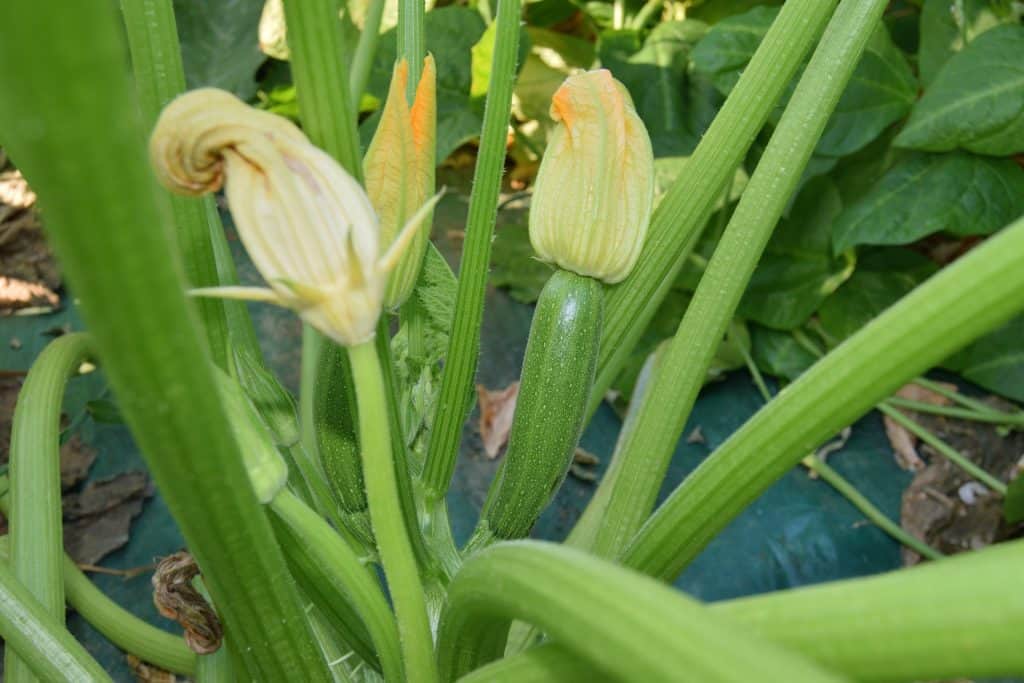
When to Plant Zucchini
Zucchini plants cannot withstand freezing temperatures, so you will want to plant it in spring or early in the summer. If you live in a warm climate, you can plant earlier. It will grow best when the soil temperature reaches 55 degrees Fahrenheit or more. The optimal outdoor temperature is at least 70 degrees Fahrenheit.
The United States Department of Agriculture (USDA) Plant Hardiness Zone Map divides North America into 13 hardiness zones based on the average annual minimum winter temperature. Each zone represents a 10°F (5.6°C) difference in average annual minimum temperature.
If that sounds confusing, don’t worry. The colder your area, the lower the number, and the hotter the area, the higher the number.
Zucchini thrives in USDA hardiness zones 3 – 9. It’s a bit more difficult to grow in zones 11 and 12 due to the heat. Use the following as guidelines for your specific location and microclimate. (Once you find your zone, skip the rest of this section, and keep reading.)
Zones 1 – 2:
- This zone can be found in Alaska, some areas of the northeastern US, northern Minnesota, Upper Peninsula of Michigan
- Plant zucchini in mid-to-late May after the last frost date.
Zone 3:
- Covers parts of northern US, including Maine, Montana, North Dakota
- Plant zucchini in early-to-mid-May after the last frost date.
Zone 4:
- Includes parts of the northern US and some higher elevations in the West
- Plant in late April-to-early May after the last frost date.
Zone 5:
- This zone covers parts of the northern US and the upper Midwest.
- Plant zucchini in mid-to-late May after the last frost date.
Zone 6:
- Includes parts of the Midwest, Northeast, and Pacific Northwest
- Plant mid-to-late May after the last frost date.
Zone 7:
- Covers much of the central and eastern US, including parts of the Southeast
- Plant zucchini early-to-mid-May after the last frost date.
Zone 8:
- Parts of the South, as well as some areas in the West
- Plant zucchini in early-to-mid-April after the last frost date.
Zone 9:
- Includes parts of the Southwest and some coastal areas in the Southeast
- Plant early-to-mid-March after the last frost date.
Zone 10:
- Includes much of the southern US, including Florida, southern Texas, and parts of California
- Plant zucchini in late February to early March after the last frost date.
Where to Plant and Grow Zucchini
There are things to keep in mind when you consider where to plant zucchini:
- Sunlight: Full sun
- Space: One zucchini plant per square foot
- Plan to grow several zucchini plants for effective pollination
Sunlight
The ideal location to plant zucchini is in a full-sun region with lots of room for spreading. They need at least six hours of sunlight a day, and they can handle up to 10 hours of direct sunlight.
Enough Space
Give zucchini plants enough space to grow. Use the square foot gardening method which I’ve had great success with. When planting zucchini with square foot gardening, you are to plant one zucchini plant or seed for every two 12’x12′ spaces.
This is a general rule of thumb to give plants enough space to vine and spread and to help prevent diseases and pests. It doesn’t have to be exact.
- 4×4 gardening bed: 8 zucchini plants
- 4×6 garden: 12 zucchini plants
- 6×8 garden: 16 zucchini plants
This equals one seed or starter plant in the middle of each space.
Because of their spread, allow for 18 up to 36 inches (2 – 3 feet) between zucchini plants. This will allow them to grow and allow for air circulation among plants. When you space plants far apart, the leaves can dry and have less chance of spreading diseases such as powdery mildew.
You can also use a trellis if you grow bush zucchini but you will need to help support it to climb. Train it by helping the vines up the trellis.
Drainage and the Soil
The area needs to drain well to avoid becoming soggy. Amend the soil with compost so it drains better. I utilize the square foot gardening method with my fruit-bearing garden and amend it with equal parts compost, peat moss, and vermiculite. Whether you have good or bad soil, amend it between plantings so it’s nutrient-dense.
Planting zucchini on hills also solve the drainage issues that flat rows can have.
Grow Several Zucchini Plants
Zucchini plants grow female and male flowers so you can grow just one plant, and it can bear fruit. However, male flowers and female flowers need to be open and pollinated at the same time for the females to grow zucchini fruits. Planting more than one plant will increase the chances for pollination which will result in greater yields.
Another tip is to keep zucchini plants together to increase pollination. Doing so means you’ll have a higher chance of harvesting more fruit if you don’t get to them in time to hand-pollinate.
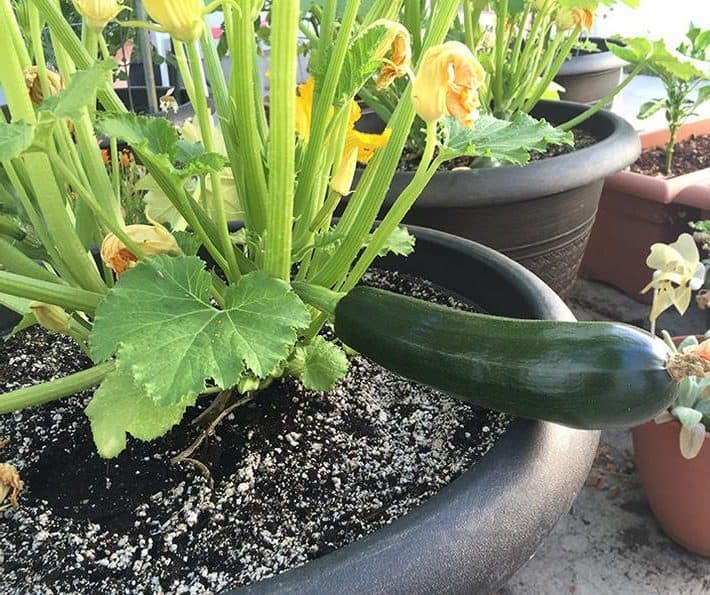
Growing Zucchini in Pots and Containers
You can grow zucchini in pots and containers if they are large enough. There are some zucchini varieties that do well in containers. These are bush types which vine less. They are better suited for small garden spaces and for container gardening.
Soil for Zucchini = Nutrient-Rich Soil
If you have the time for it, you can prepare the soil a few months before the growing season. Otherwise, buy organic soil that’s already amended with compost. It’s important to have fertile, well-draining soil.
Be sure to amend the soil (enrich it) before planting seeds or starter plants.
When growing zucchini it’s best to have loamy soil. You can achieve the ideal conditions by mixing compost with gardening mulch to add the needed nutrients to the native soil.
If you want to take it a step further, you can test the soil pH to ensure it is between 6 and 7.5. Buy a soil test kit at a garden center or home improvement center such as Ace Hardware, Home Depot, Menards, or Lowes. An accessible way to alter soil pH to make it more acidic is by adding pine needles or peat moss. You can make it more alkaline with lime.
Tilling compost or aged manure into the soil one month before planting and covering it with mulch can add even more nutrients to the soil. Adding a bit of sand will encourage drainage.
Growing from Seed vs Starts Pros and Cons
Growing Zucchini from Seed
Pros:
- Seeds are readily available and easy to find.
- Fast-growing: Germination will take place in 10 – 14 days.
- It’s typically less expensive to plant from seed than to grow from starts. This is because a packet of seeds can contain 20 or more seeds giving you the chance to grow that many plants.
Cons:
- Not all the seeds may grow.
- If you plant more than one seed per hole, you will need to thin them out by keeping the strongest seedling.
Growing Zucchini from Starts
Pros:
- Somewhat easy to find at a home improvement center or nursery or garden center.
- Easy to transplant from the store’s container to your garden
- Plant is already established; greater chance for survival
- Will bear fruit sooner
Cons:
- Zucchini plant starts can cost $4 or more each.
How to Plant Zucchini
Now that you have made the necessary preparations, you can start planting zucchini.
- Prepare the area. Work the soil with a gardening trowel or spade so it’s loose. Remove rocks, sticks, etc.
- Amend soil with compost, peat moss, vermiculate, etc.
- Measure area in order to plant one plant per every 2 square feet.
How to Plant Zucchini from Seed
- Plant 1 – 2 seeds per hole.
- Plant seeds 1 inch deep.
- If you plant 2 seeds and each sprout: Once they grow to 2 inches or when they have 2true leaves, snip the weaker plant, and keep the bigger, stronger plant.
Plant seeds where you want them to grow. There is no need to transplant them unless you start them indoors.
How to Plant Zucchini from Starts
- With starts, dig a hole a bit deeper and wider than their root balls.
- Loosen the plant from the container.
- Place the transplant in the hole, making sure it’s straight.
- Fill in with soil to cover the root ball entirely. The transplant needs enough soil to cover the root ball.
- Gently press down on the soil so it’s firm.
- Add extra soil so the plant is sturdy and straight.
Make sure to plant each zucchini plant about 24 – 36 inches away from each another.
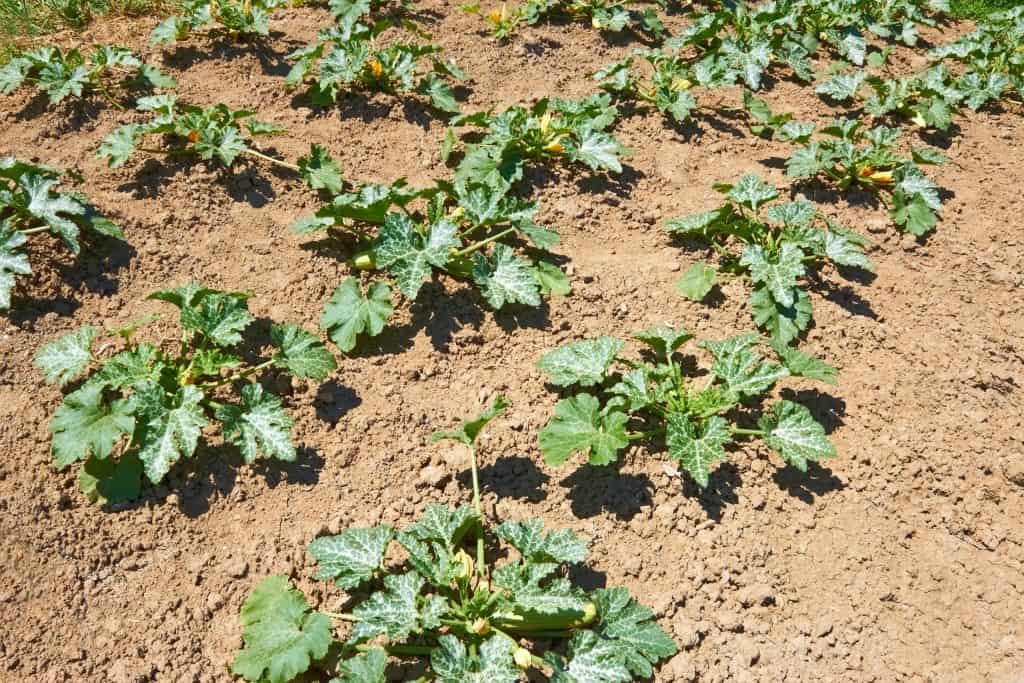
Watering
Like all plants, your zucchini plant will need some care. Zucchini prefer moist soil, so water it heavily whenever it dries. It’s important to not let the soil get too soggy in order to prevent root rot. Planting on small hills or adding some sand should help with this issue.
Try to water the plant so the leaves don’t become wet. This can promote disease.
Apply 1 – 2 inches of water per week. This help the soil stay moist about four inches down. Factor in rainfall. Consider using a soaker hose in order to water the plant under the leaves. It’s important to try to keep the leaves dry.
Make sure to check the soil more frequently when it starts developing fruit. Keep up with the consistent watering during the growth period.
Fertilizer
If you’ve used nutrient-rich soil to plant zucchini, then you won’t need to fertilize the plants until just before the flowers will bloom. Mix in a water soluble or granular fertilizer. Choose a basic 8-8-8 or 10-10-10 organic fertilizer.
If you aren’t able to amend the soil before planting, mix in some fertilizer before planting zucchini seeds or starts. I do not fertilize my garden because I grow in garden beds and pots and enrich my soil before every planting.
If you want to fertilize, I recommend natural fertilizers over Miracle Grow, etc. Ask at your local nursery or garden center what they recommend for your area.
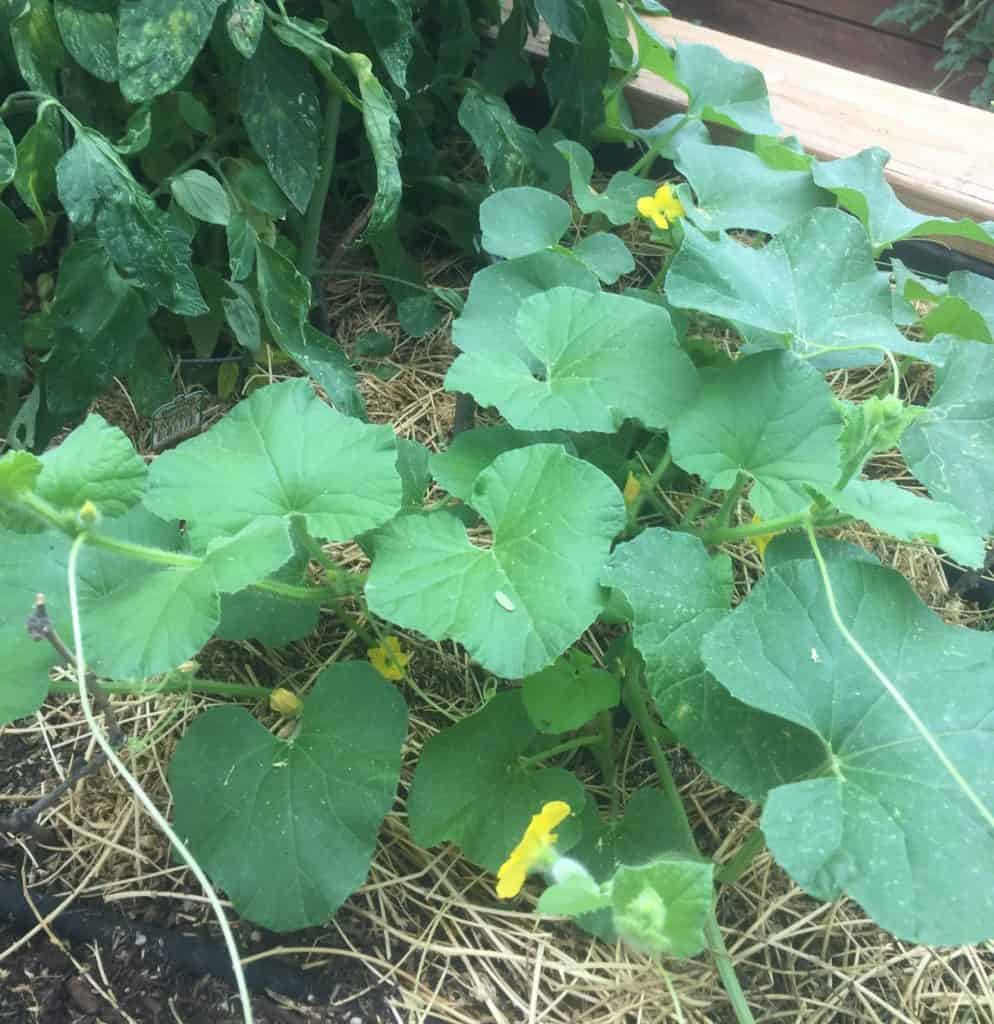
Companion Plants
If you have room in the garden, there are several plants which grow well together. You can grow zucchini with other squash, corn, and pole beans. Tomatoes grow well with zucchini too.
Zucchini plants are heavy feeders. You’ll want to avoid planting them with potatoes.
Additionally, while zucchinis grow well with melons, they attract the same type of pests. You may consider keeping them apart to not attract the same types of pests and diseases. You don’t want an issue and your entire garden gets destroyed from pests.
You may not want zucchini plants next to other vining plants because they will take up a lot of space in your garden. Again, remember zucchini plant spacing. They need space to thrive.
Pests and Disease
While they are among the easiest vegetables to grow, (yes, zucchinis are fruits!) zucchini growing sometimes attracts pests. Watch out for squash vine borers. These squash bugs emerge in the summer to lay their eggs in squash plants like zucchini. They are moths. Hatchlings burrow into the plants to feed, which reduces water flow to the stems and kills your zucchini.
If you plant your zucchini in mid-summer, you can avoid squash vine borers. If you plant early, you can tightly wrap the stem bases with aluminum foil to prevent larvae from boring through.
Other pests include cucumber beetles which are small yellow beetles with spots or stripes.
If you live in an area with raccoons, deer, or javelina, be sure to cover your plants. They will eat the zucchini plants, including leaves, stems, and zucchinis.
Watch for fungal diseases which are common. Some zucchini plant diseases to watch out for include:
- Cucumber Mosaic Virus
- Blossom End Rot – caused by a calcium deficiency
- Bacterial Leaf Spot
- Powdery Mildew
- Bacterial Wilt
Zucchini Pollination
Helping with pollination may be necessary when growing zucchini. This means you will pollinate the flowers by hand.
You do not need two zucchini plants to produce fruit. This is because they are monoecious. They grow separate female and male flowers on the same plant. Therefore, you can grow just one plant if you want.
Zucchini plants often produce primarily male flowers, so the fruit will take a while to form due to the female blossoms not opening. The male flowers will attract pollinating insects to the region.
Zucchinis need male and female flowers to open simultaneously to set fruit. Growing more plants, increases the chances for more flowers to be open and pollinated.
You may need to hand-pollinate if:
- Your garden does not seem to attract bees and other pollinators
- The plants are flowering but aren’t producing fruit
How to Pollinate Zucchini Plant
It’s best to hand-pollinate in the morning. The flowers will be open.
- Identify the male and female flowers.
- The females will have a little bulb or ovary between the flower and the vine. This is the unfertilized fruit.
- Locate a male flower.
- Take a Q-tip or a small paintbrush, and insert it into the male flower. Brush gently, and swab some pollen.
- Dust the pollen from the male flowers onto the female ones.
- Repeat until you pollinated all the female flowers.
Identifying Male and Female Zucchini Flowers
Female flowers are closer to the main vine than male flowers. You will see a bulb or ovary between the flower and the vine. This is the unfertilized fruit. It may be fuzzy.
Male flowers will have only the stem and the flower.
After You Hand Pollinate
Once you have pollinated the female flowers, you can pick the male flowers. They are edible raw or cooked. DO NOT PICK the female flowers as these are the flowers which will grow zucchinis.
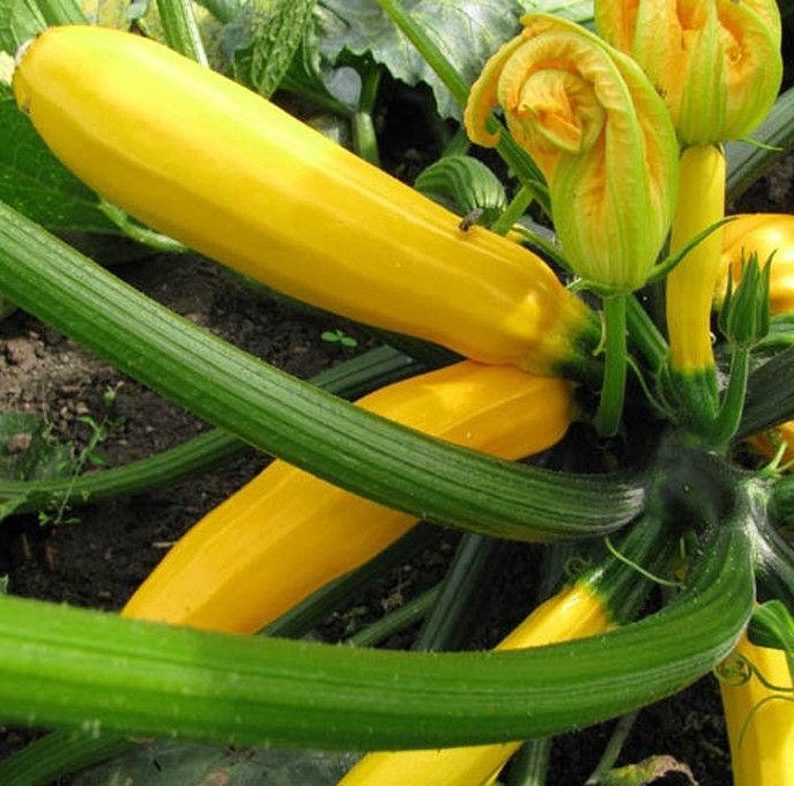
Harvesting Zucchini
Check the Days until Harvest or Days to Maturity (DTM) for the type you buy. Typically, mature zucchini fruits take 55 – 60 days to grow from seed.
They will be tasty from 3″ – 8″ long. You can grow zucchini to your preferred size, however, younger and smaller they are, the more tender they are. Zucchinis can grow 1 – 2 inches each day.
Being warm weather plants, they will produce in summertime. Harvest zucchini so the plant will use energy to grow more. Don’t leave them on the vine. The larger they grow, they more fibrous and/or watery they become.
- Use scissors or a sharp knife, and cut the stem one inch from the fruit.
- Harvest the fruits when the vines are dry. If they are wet, it’s easier to spread diseases.
Gently pick zucchinis, being careful to not disturb the plant.
It takes about 2 months for their harvesting to complete, so you will want to plant them as soon as possible to get multiple harvests during the fruiting season.
Tips for Healthy Zucchini Plant
Zucchini plants are fairly low-maintenance. To maximize growth and harvest, consider the following:
- You will want to plant the seeds 4 – 6 weeks before the growing season to maximize yield. Be sure there is no chance of frost.
- Add a layer of mulch to prevent weeds and to contain moisture. This is especially important in dry climates. It will also help to stabilize soil moisture levels.
- Make sure to remove weeds that appear as soon as possible. Try to pull them from the roots to prevent regrowth. Cut off shriveling or dead weeds.
- Organic matter makes a strong fertilizer which adds nutrients to the soil.
- Fresh compost can keep the roots moist and cool to encourage growth. This will aid fruit production.
- Note when female flowers bloom, and pollinate each female with a male flower. (Morning is best.)
- There is no need to prune zucchini plants.
Consider also growing zucchini with other methods such as hydroponics and with straw bale gardening. Zucchini plants do well with these methods.
Zucchini Plant Varieties and Types
Most common are green fruit but there are also golden and striped varieties. Check where you live to learn the recommended variety for your area. Popular types of zucchini to grow from seeds are:
- Fordhook
- Italian Ribbed
- Black Beauty
- Spineless Beauty
- Tigress
- Golden
- Mid-East Clarimore
- Cocozelle
FAQs
Why aren’t my zucchini growing?
If there are flowers on your zucchini plant, go out the next morning with a Q-tip or small paintbrush and pollinate them yourself. Identify the male flowers (short stems) and the female flowers (has a small bulb growing). With Q-tip, gently swipe some pollen from the male stem and brush it on the female stem. Do this so all the female flowers receive male pollen.
What does zucchini look like when it’s growing?
When pollinated (by you, insects, or the wind), zucchini will start growing out of the female flowers. There will be a small bulb growing which will get larger each day.
Can you grow zucchini from zucchini?
You are better off buying seeds than harvesting them from an existing zucchini. The exceptions are if you know how to save zucchini seeds properly, and if you harvest seeds from heirloom or organic varieties. Planting seeds from edible zucchini is not recommended. They are still immature, and the seeds aren’t ready to plant.
Does zucchini grow fast?
Zucchini is a fast-growing fruit, and can reach maturity in 45 to 60 days, depending on the variety and growing conditions.
Do you need 2 zucchini plants to get fruit?
No, you do not need 2 zucchini plants to get fruit. Zucchini plants have both male and female flowers on the same plant. However, both male and female flowers must be opened at the same time and pollinated in order for the females to grow into zucchini.
Growing multiple plants can increase the chances of successful pollination and lead to a larger harvest.
What temperature does zucchini grow best in?
Zucchini grows best in warm temperatures between 60°F and 75°F (15°C to 24°C). A minimum of 6 hours of sunlight each day is important.
What type of soil do I need to grow zucchini?
Zucchini prefers well-drained soil, rich in organic matter. Fertile soil with a pH between 6.0 – 7.5 can promote faster growth.
How often should I water zucchini plants?
Zucchini needs consistent moisture to grow quickly, but overwatering can lead to root rot. Pay attention to rainfall and water accordingly. Aim to keep the soil moist but not waterlogged. Water regularly, one a week. Water more in drier, hotter climates. Irregular watering can stress the plant and cause disease.
In hot dry climates, such as hardiness zone 9b, you will need to water more frequently than in zones 5a and 5b, unless there are heavy monsoons.
How long does zucchini take to grow from seed?
Days to maturity (DTM) for zucchini depends on the variety. Some bush varieties can reach maturity in 45 days, while some vining varieties may take up to 60 days.
Do zucchinis like full sun or shade?
Zucchinis are warm weather fruits and prefer full sun. To grow well, they need at least 6 hours of direct sunlight per day. They can tolerate some shade, but their growth and yield may be reduced.
How long does it take for a zucchini plant to produce fruit?
Zucchini plants can begin producing fruit in as little as 45 – 60 days after planting, depending on the variety and growing conditions. It can take longer in cooler temperatures and/or if the plants don’t have enough water or nutrients. (Start with good soil so this won’t be an issue.)
What month do you plant zucchini?
The best time to plant zucchini varies depending on your location and climate zone (USDA hardiness zone). In general, you should plant zucchini after the last frost date in your area when soil temperatures have warmed up to at least 60°F (15°C).
This can range from late winter to early summer, depending on your climate. You can check with your local cooperative extension service for specific planting recommendations for your area.
Is zucchini a fruit?
Yes, zucchini is botanically a fruit. It has seeds. However, many people treat it as a vegetable because it’s not as sweet as many fruits are (and because, in my opinion, it’s green).
Homegrown Zucchini
Zucchini is known for its rapid growth and can produce an abundant harvest in a relatively short amount of time. It’s important to monitor its growth to check for pests and diseases to ensure healthy and productive plants. Note when the flowers start to form. Go out in the morning when the flowers open, and hand pollinate them.
Healthy plants are easy to grow when you follow these steps. It’s rewarding to harvest and eat homegrown zucchini. There are so many ways to use them. They will add to the flavor of your meals. You can cook, steam, roast, and sauté this summer squash. You can also eat it raw. There is no need to peel it.
You can grate it or spiral zucchini and use it as noodles or in salads. I have an easy-to-use vegetable spiralizer which makes it fast. They are good in baking too for treats like zucchini bread.
If you are growing a vegetable garden for the first time, growing a zucchini plant is a way to produce lots of fruits.
Overall, zucchini is one of the easy fruits you can grow in your garden. You do not need a green thumb to grow them. As long as you prepare your garden plot, use high-quality soil, plant them with enough space, and keep the plant hydrated, you can grow gorgeous zucs all summer long.
When pollinated, they grow quickly and provide an abundant harvest with minimal care.

